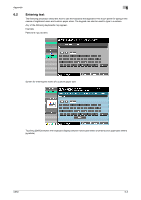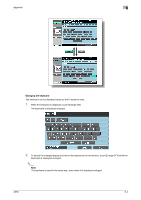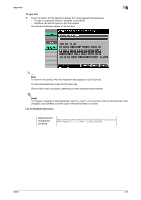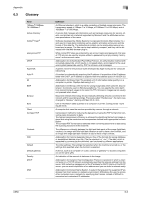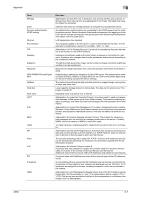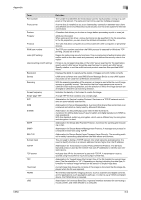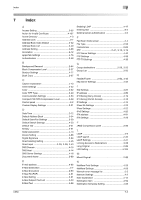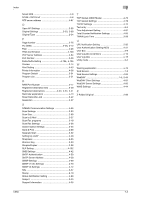Konica Minolta bizhub C650 bizhub C650 Network Scanner Operations User Guide - Page 298
Abbreviation for Management Information Base. In a TCP/IP transmission, this uses
 |
View all Konica Minolta bizhub C650 manuals
Add to My Manuals
Save this manual to your list of manuals |
Page 298 highlights
Appendix Term Kerberos LAN LDAP LPD LPR/LPD MAC address Memory MH MIB MMR NetBEUI NetWare NTLM NTP OCR OS PASV Peer-to-peer PDF Pixel POP POP Before SMTP C650 6 Definition A type of network authentication system used by Windows 2000 or later. Used in Active Directory authentication. Users can be safely and efficiently authenticated with a two-phase authentication (user logon and network resource usage) on a dependable site set up on the network. Abbreviation for Local Area Network. A network which connects computers on the same floor, in the same building, or in neighboring buildings. Abbreviation for Lightweight Directory Access Protocol. On a TCP/IP network, such as the Internet or an intranet, this protocol is used to access a database for managing environment information and the e-mail addresses of network users. Abbreviation for Line Printer Daemon. A printer protocol that uses TCP/IP and is platform-independent. Originally developed for BSD UNIX, it has become the standard printing protocol and can be used with any general computer. Abbreviation for Line Printer Request/Line Printer Daemon. A printing method over a network in a Windows NT system or UNIX system. Using TCP/IP, you can output print data from Windows or Unix to a printer over a network. Abbreviation for Media Access Control address. With a special ID number for each Ethernet card, data can be sent and received between the cards. A number consists of 48 bits. The first 24 bits consist of a special number for each manufacture controlling and assigning IEEE. The last 24 bits consist of a number that the manufacturer assigns uniquely to the card. Storage device for storing data temporally. When the power is turned off the data may or may not be erased. Abbreviation for Modified Huffman. A data compression encoding method for fax transmissions. Documents containing mostly text are compressed to about 1/10 their original size. Abbreviation for Management Information Base. In a TCP/IP transmission, this uses SNMP to define the management information format for a group of network devices. There are two formats: the manufacturer-specific private MIB and the standardized MIB. Abbreviation for Modified Modified Read. A data compression encoding method for fax transmissions. Documents containing mostly text are compressed to about 1/20 their original size. Abbreviation for NetBIOS Extended User Interface. A network protocol developed by IBM. By simply specifying the computer name, you can build a small-scale network. Network operating system developed by Novell. NetWare IPX/SPX is used as the communication protocol. Abbreviation for NT LAN Manager. User authentication method used by Windows NT or later. With the MD4 and MD5 encoding methods, passwords are encoded. Abbreviation for Network Time Protocol. The protocol for correctly adjusting the computer's internal clock over the network. In a hierarchical method, the time is adjusted with the server at the highest level using GPS to acquire the correct time, which is then referenced by each lower level host. Abbreviation for Optical Character Reader. A device or software that converts handwritten or printed documents to text data by optically scanning it and, through comparison with a previously stored pattern, specifies the characters. Abbreviation for Operating System. Basic software for controlling the system of a computer. Abbreviation for PASsiVe. A mode for connecting to an FTP server from within a firewall. If this mode is not specified, the firewall will be considered inaccessible and the connection will be terminated, preventing the file from being sent. A network format that allows connected devices to communicate without using a dedicated server Abbreviation for Portable Document Format. An electronically formatted document which uses the .pdf extension. Based on the PostScript format, you can use the free Adobe Acrobat Reader software to view documents. An image pixel. The smallest unit of an image. Abbreviation for Post Office Protocol. A protocol for retrieving e-mail messages from a mail server. Currently, POP3 (the third version of POP) is most often used. A user authentication method for sending e-mail messages. First, the reception operation is performed and the user is authenticated by the POP server. Then, IP addresses where the user was successfully authenticated by the POP server are permitted to use the SMTP server. This method prevents third parties without permission to use the mail server from sending mail messages. 6-8



